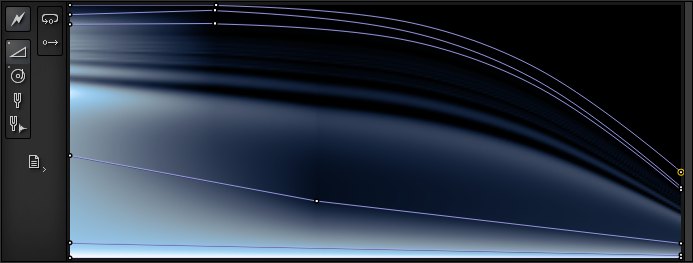Envelopes |

Envelope demonstrating a looping region in yellow and release curve in red. |
Sustain & Loop PointsEnvelope points can be tagged as loop- or sustain-points by selecting a single vertex and clicking the corresponding sustain/loop buttons on in the controls area. The last vertex in the envelope is treated as the sustain point by default. All points after the sustain vertex
are treated as part of the release curve. To make a vertex the sustain point, select it and hit the sustain icon
( To set a loop start point, select a vertex that's at least two behind the sustain point and hit the loop icon
( |

Release RegionBecause these are multistage envelopes, there's no direct correspondence with the ASDR paradigm. But there are two regions: the main region and a release region, separated by the sustain point. If you add vertices to the release region, they will always get treated as part of the release curve. However, the release curve can start before this region if the sustain vertex somewhere in the middle. |
3D Envelope Editor
When you make either Red or Blue the primary viewing axis (by clicking the appropriate x-axis button), then the 3D envelope editor replaces the 2D editor. This editor visualizes the envelope as it varies along the chosen x-axis range, with time always as the y-axis. Light coloured areas are high amplitude; dark coloured areas are low amplitude. The horizontal lines are the paths the nodes of the envelope follow along the range you selected. In this editor you may adjust the position of the ends of the node path and chop the path into segments with the Axe tool. |
Envelope Types |
 Wave PitchThis pitch envelope is applicable only when a reference sample is loaded. When you load a sample, Cycle tracks its pitch over time to visualize the cycles properly, and it automatically defines the estimated pitch curve in this envelope. But this automatic tracking is not always accurate. You can edit the generated curve to more accurately reflect the real pitch curve of the sample. |
 Scratch Envelope(s)What is it?This envelope distorts the timeline of a layer's wireframe. So for example, what might have been a slow filter sweep could easily become a quick decay by moving one vertex in the scratch envelope. It works by mapping an input time to an output time according to the drawn curve, like a lookup-table. You can think of the unwarped voice as a palette of possible sounds, which can be rearranged in interesting ways
by the scratch envelope.
MappingIn fact, unlimited scratch envelopes are available; you may add as many as you like. Each one can be mapped to one or many layers, making them get 'scratched' by that envelope - this mapping
is done in layer controls sections of the time surface or
spectrum filter.
LFO behaviorSince the wireframes of wave-shape and spectral filter layers have a prescribed duration in Cycle (set by the duration slider), using this envelope's loop feature can keep a sound evolving indefinitely, where otherwise it would become static in timbre after the note was held past the preset duration. |
Controls
|
 ).
).
 ).
).

